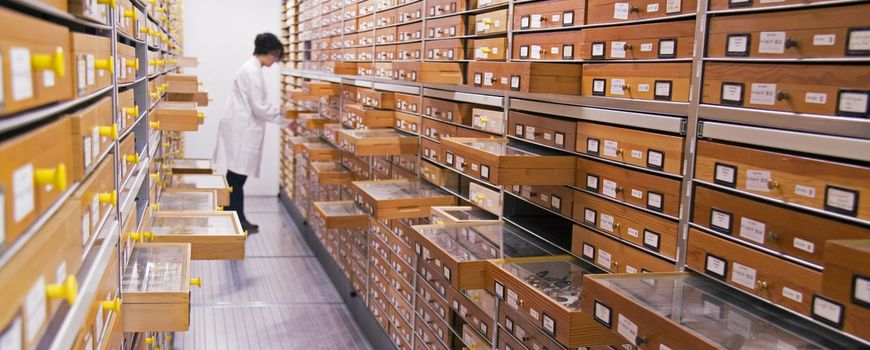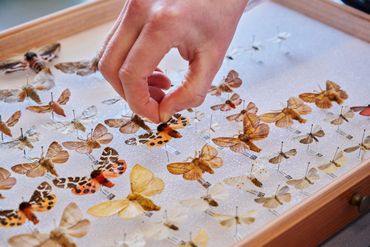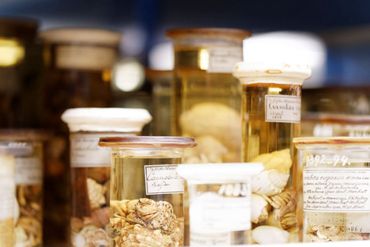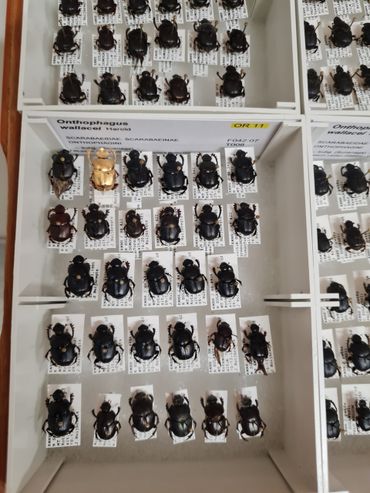Various parts of the Naturalis collection have fallen into disrepair. The administrative backlog is due to various reasons, such as the significant growth of the group due to mergers, new construction works, mass transportation, the Corona pandemic, and backlogs from the past. To get rid of this backlog, Naturalis started a major project called “CollAction”.
The project was made possible thanks to a financial contribution from the Ministry of Education, Culture and Science. Catching up on a group’s backlog is specialized work. Different types of groups therefore require their own approach. “For this reason, this project is organized into a number of work packages through which the work is carried out,” says Steven van der Meij, Collection Policy Officer. “In this way, the CollAction team is restoring the collection to a state that will enable future research.”
Data treasure
The Naturalis Collection Tower houses more than 43 million objects of natural history. Composed of plants, animals, fungi and minerals, this enormous collection forms a catalog of the Earth and all life on it. All of these things are of great value to science. Together they constitute a wealth of biological and geological data. The collection is the foundation for research into the past, present and future of biodiversity. This is certainly a necessity these days, because in order to protect nature we must first understand it (better).
Risks to the group
Keeping a collection of more than 43 million objects in good condition for future generations is a huge responsibility. This enormous collection has been amassed over centuries and requires a lot of maintenance, as natural history collections are very sensitive to wear and tear. Items stored in liquids, such as alcohol or formalin, can dry out and become lost due to evaporation from leaky jars. Insect pins can oxidize and expand, causing the body to collapse. If the boxes are too full, the fossils crush and damage each other. These continuous processes ensure that the quality of things slowly deteriorates.
Collection in safe hands
CollAction began in January 2024 and is planned to run for two years. The plan is very labor intensive which is why more than 25 employees have been deployed. Together they form the CollAction team. The team is sometimes shocked by the condition of the collection, but they work hard every day to check the collection and put it back in order. “The work we do in this project is diverse, because we work with many different types of collections,” says Valerie van de Scherer, a project employee. “For example, we have got beetles, butterflies and now cow bones.” “I think the most unique thing about this business is that we can work with so many different pieces of art.” The team’s work includes cleaning, arranging, packaging, inventorying, selecting, or digitizing collection items.
A project full of stories
This team sees a large portion of the group every day. Therefore, they sometimes encounter special surprises. A historical collection is sometimes prepared or maintained in a very different way than is usual today. For example, part of the Apollo butterfly collection was preserved using the strong-smelling naphthalene, a now-banned chemical used in mothballs. “The smell was so distracting that it bothered other employees in the lab,” says project employee Mickey Boehmer. “We regularly encounter such surprises in this project,” adds Sabine Hilgersum. “We then have to work flexibly and solve the problem.” “Then we moved to another lab. We could use fume hoods there so the smell wouldn’t bother us.”
“The best thing about this work is the amazing array of elements we sometimes encounter,” says project officer Tamar van Mierkerk. In the beetle collection, the team found sparkling gems: golden beetles. In the past, a number of beetles have been sprayed with a thin layer of gold so that electron microscopic images of the beetles can be taken. “The best thing I found was a collection of little anemones for the then Princess Juliana,” says Valerie. “We found it with a picture of Juliana and a little message. Then you really see what kind of history there is behind the collection.”
more information:
- The CollAction team shares its own experiences and discoveries on Collection page. This way you can stay up to date with the latest news and stories from CollAction.
- If you have any questions, please contact Steven van der Mije, Chief Collection Policy Officer, at [email protected]
Text: Omaima Al-Zamouri, Natural Biodiversity Centre
Photos: Center for Natural Biodiversity. Goofy will tell you; Nico Garstmann; Setsky de Wart

“Total coffee specialist. Hardcore reader. Incurable music scholar. Web guru. Freelance troublemaker. Problem solver. Travel trailblazer.”












More Stories
Brabanders are concerned about climate change.
The “term-linked contract” saves space on the electricity grid.
The oystercatcher, the “unlucky national bird,” is increasingly breeding on rooftops.